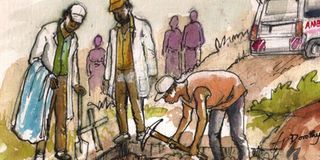Death in police custody: solving the puzzle, part III

What you need to know:
- If the deceased had died as a result of the hanging then the blood draining from the head would have been visible above the tight sleeve in the neck.
- Instead the discolouration over the left arm indicated instead that the body of the deceased was lying on the left side before it was hanged up.
The remains of a young man who died while in police custody were exhumed one year and seven months after he was buried. This was as a result of an inquest (a legal inquiry) into this particular death. The doctor who carried out the post-mortem examination the day the young man died had concluded that the inmate hanged himself. Some people thought otherwise and contested this conclusion and applied to court to investigate this death.
The second post-mortem examination, carried out following the exhumation, failed to establish a cause of death and the circumstances thereof; the body had decomposed to such an extent that no meaningful conclusion could be reached in respect of a cause of death. The doctor then requested for a copy of the first post-mortem report and photographs the police scenes of crime officer had taken the day the body of the young man was discovered in the police cells.
The coloured photographs showed the naked body of a young man in various positions with wounds especially on the buttocks. The first photographs taken were of the body hanging by the sleeve of a blue jacket from a metallic door. The sleeve of the jacket was knotted and tied very tightly around the neck of the deceased. The area above the sleeve of the jacket in the neck did not show any colour change. However, the eyes and the mouth of the deceased were normal.
The photographs clearly showed both arms of the deceased at an angle in front of the body and at an angle to the door. On the left arm there was a linear area that was devoid of a colour change and this was uniquely different from the rest of the arm. The left leg was also bent at the hip and knee joints and these positions were maintained in the various photographs.
The doctor told court that there was no doubt in his mind that the deceased had died prior to his body being hanged in that particular position. He told court that one of the close-up photographs showed that there was no discolouration what-so-ever of the skin above the sleeve of the jacket in the neck.
The doctor explained to the coroner that when someone dies the heart stops pumping blood to the rest of the body. Blood in any part of the body would then drain downwards due to the force of gravity. And in this particular case, the blood from the head should have drained to the neck and further drainage should have been stopped by the sleeve of the jacket.
If the deceased had died as a result of the hanging then the blood draining from the head would have been visible above the tight sleeve in the neck. Instead the discoloration over the left arm indicated instead that the body of the deceased was lying on the left side before it was hanged up.
New evidence
Various photographs showed that the arms of the deceased were clearly at an angle to the body. The doctor explained to court that when a person dies the body loses control and it obeys the laws of gravity. Where a person hangs himself the hands will obey the gravity and point downwards and after sometime the body will start to stiffen in that position. From the photographs it was therefore, clear that death in this case was inconsistent with suicidal hanging.
In a post-mortem examination of a case of suicide by hanging the doctor told court that that knot should have been examined to determine if it could have been made by the deceased. In this case the sleeve appeared to have been knotted several times, making this inconsistent with suicide. The knots were clearly made by another person.
To be concluded next Saturday




